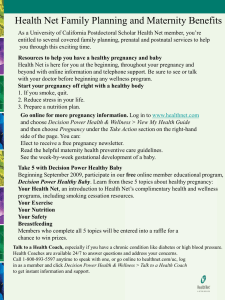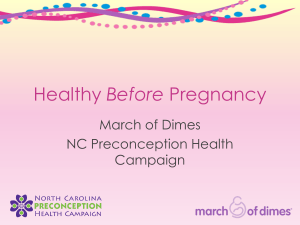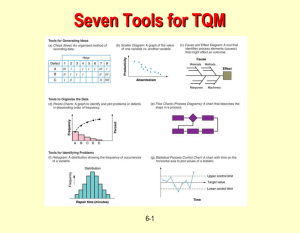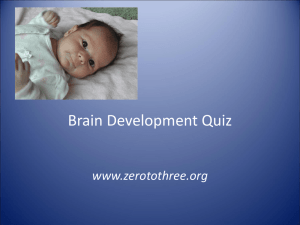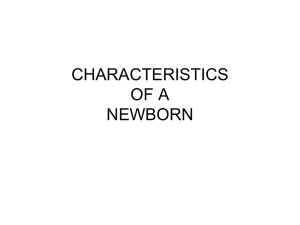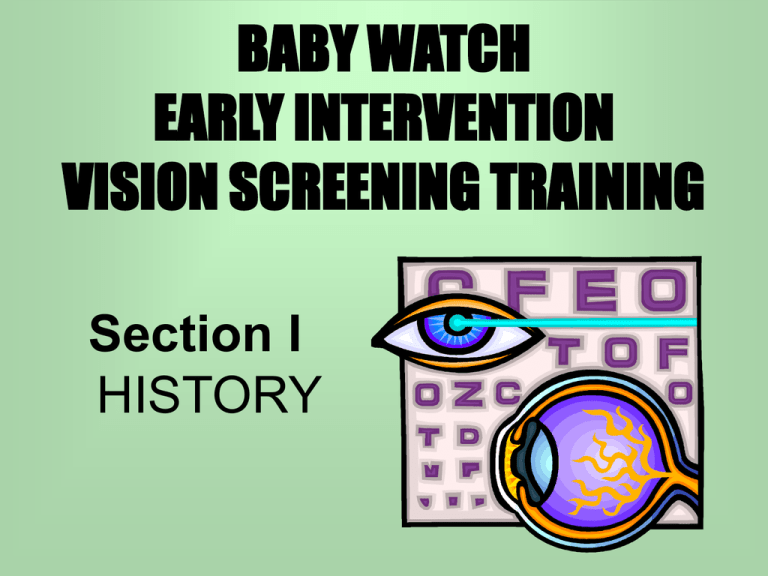
BABY WATCH
EARLY INTERVENTION
VISION SCREENING TRAINING
Section I
HISTORY
BABY WATCH
EARLY INTERVENTION
VISION SCREENING TRAINING
Part A:
Child’s History
Part A: Child’s History
The child’s history provides information that is very
pertinent to determining the need for more vision
testing.
Medical and parent reports.
It is important to be aware of the parent’s ability to
be a good historian about the child’s health.
Use methods appropriate to determine the most
accurate information.
Low Birth Weight
Prematurity
Most of the premature children
should have already been
tested by an Ophthalmologist
Make sure that testing has
occurred!
Low Birth Weight
Prematurity
Retinopathy of Prematurity (ROP):
Occurs in some premature babies
Growth of abnormal blood vessels in the retina
Generally begins during the first few days of life
May progress rapidly to blindness over a period of
weeks
The eye is rapidly developing during gestational
weeks 28-40.
The blood supply to the retina starts at the optic nerve
blood vessels grow out toward the edges until birth.
Retinopathy of Prematurity (ROP)
When a baby is born prematurely, normal vessel
growth stops, new abnormal vessels begin to grow.
Fibrous scar tissue attaches to the retina and the
vitreous gel that gives the eyeball its shape.
The ring may extend 360 degrees around the inside
of the eye.
If enough scar tissue forms,
it can begin to pull the retina,
detaching it, and in some cases
cause blindness.
For further information
http://www.tsbvi.edu/Outreach/seehear/winter98/rop.htm
Retinopathy of Prematurity (ROP)
Due to modern medical procedures, only 400 babies
a year go blind from this condition.
In the 1950's the number of babies
blind from (ROP) reached epidemic
proportions.
For further information:
http://www.99main.com/~charlief/vi/disorders.html
Diabetes Mellitus
Diabetes Mellitus, (general term)
refers to disorders characterized
by excessive urine excretion;
a metabolic disorder of
carbohydrate metabolism.
Diabetic Retinopathy is a
complication that can cause loss
of visual acuity (restricted vision
or blindness).
Scene viewed by a person
with diabetic retinopathy
Diabetes Mellitus
Diabetes damages the normal circulation of the
body, including legs, kidneys, heart, brain and eyes.
Initially, diabetes causes the retinal vessels to leak
resulting in retinal swelling (macular edema) and
vision loss. The leaking vessels can be sealed with
a laser to resolve the swelling and prevent further
vision loss.
Significant macular edema may be present even if
vision is excellent.
For further information, The National Eye Institute:
http://www.nei.nih.gov/health/diabetic/retinopathy.asp#1
http://www.retinadoc.com/services/diaret2.stm
DIABETES
Diabetic children can
develop blurred vision,
and sometimes cataracts,
due to fluctuating blood
sugars, the fragility of
blood vessels behind the
eye, which break easily
and bleed, scarring then
develops on the retina.
Glaucoma and retinal
detachment are additional
problems.
MENINGITIS
ENCEPHALITIS
Meningitis is an infection of the three membranes
that envelop the brain and spinal cord.
Meningitis can cause inflammation of the
cornea and pink eye.
Encephalitis is an inflammation of the
brain, usually viral.
The infection can cause damage to the vision center of the
brain.
For further information
http://www.no-smoking.org/may99/05-12-99-3.html
MENINGITIS
ENCEPHALITIS
Did your child ever have an infection in his brain or
spine (back)?
Make sure a health care provider made the
diagnosis and get information about how severe
the case was, such as length of time and
incapacity following illness.
HEAD TRAUMA/TUMOR
A brain injury due to a significant illness or injury,
can cause one or a combination of the following:
a decrease in visual acuity, a decrease in visual
field, a strabismus or crossing of the eyes, cortical
visual loss, optic nerve atrophy, double vision, blur,
eyestrain, difficulty with visual judgments in space,
and impaired visual memory.
For further information
http://www.visionhelp.com/brain.htm
HEAD TRAUMA/TUMOR
Any time there is damage to
the brain or a growth in the brain,
the occipital nerve could be
involved.
Has your child ever had any surgery on his
head?
Has your child ever had a head injury?
CEREBRAL PALSY
Cerebral Palsy is an abnormality of
motor function-as opposed to mental function,
is usually acquired at less than a
one year of age,
is due to a non-progressive brain
lesion; (a persistent motor disorder
due to non progressive damage to
the brain).
CEREBRAL PALSY
Approximately 40% of all children
with CP palsy have some abnormality
of vision or oculomotor control, and at
least 7% have a severe visual deficit
Commonly encountered visual
impairments include, nearsightedness,
amblyopia, (lazy eye), loss of vision in
segments of the visual field, and
cortical blindness (caused by
abnormalities of the brain).
Many of the visual and oculomotor
problems in children with CP can be
remediated with corrective lenses, eye
patching, or surgery.
http://www.pbrookes.com/store/books/dormans-322x/excerpt.htm
CEREBRAL PALSY
Did a doctor every say that your
child has a type of brain damage or
problem with brain cells?
If a child has a diagnosis of spastic
diplegia or quadriplegia or
hypertonia (stiffness) or hypotonia
(floppiness), they probably have
cerebral palsy.
Knowing the severity of the cerebral
palsy would be very helpful.
HYDROCEPHALY
Hydrocephaly - an abnormal accumulation of
cerebrospinal fluid in the brain.
The fluid is often under increased pressure which
can compress and damage the brain, dilatation of
the cerebral ventricles with accumulation of
cerebrospinal fluid.
hhttp://www.deafed.net/publisheddocs/sub/9906KAh.ht
m
MICROCEPHALY
Microcephaly - An abnormally small head
due to failure of brain growth--usually
associated with developmental delays.
In precise terms, microcephaly is a head
circumference that is more than 2 standard
deviations below the normal mean for age, sex,
race, and gestation.
Microcephaly may limit the ability of the infant to
have a normal brain size and structures.
HYDROCEPHALY
Has the doctor ever said that your
child has water on the brain?
Because of the chances of visual disturbances
with these conditions, the child should be
referred for further visual evaluation.
SYNDROME
Syndrome is a set of signs or a series of
events occurring together that often point to a
single disease or condition as the cause
w
w
w
Has your child been diagnosed with any
specific condition?
What is it called?
What do you know about it?
BRAIN BLEED
Did your child ever have bleeding on the brain?
Intraventricular hemorrhage is the medical term for
brain bleed.
For children with a grade I or II bleed, the
parent/caregiver may not remember or may not
have been told this.
For the possibility of a brain bleed, refer to medical
report, if available.
BIRTH TRAUMA
Do you know if your child had trouble
breathing at birth?
Caregivers may not know how long or if there
was a lack of oxygen so ask
about what was done and how
long before breathing was normal.
BIRTH TRAUMA/LACK OF
OXYGEN
The greatest issue for a baby who has suffered
a traumatic birth with a significant amount of
time without oxygen usually relates to what is
referred to as Cortical Visual Impairment.
Other problems which may been seen are optic
nerve atrophy, strabismus, and amblyopia.
SEIZURES
Seizures that are uncontrolled are
frequently accompanied by vision
problems and any documented
seizure problem (even if controlled by medication)
could make the child at higher risk for vision
problems.
Find out about diagnosed seizures.
Has your child ever had convulsions or
uncontrollable movements?
SEIZURES
The critical visual issues for children with a
seizure disorder are the problems that are a
result of the medications given to control the
seizure activity.
Blurred vision, double vision, color vision
disturbances, decreased visual acuity, visual
field constriction, nystagmus and ptosis are just
a few of the problems that may manifest due to
many of the different seizure medications.
SICKLE CELL ANEMIA
When tiny blood vessels in the eye become blocked
with sickle-shaped cells, vision problems and even
blindness can result. Some children with sickle cell
disease may need regular eye exams. When eye
problems occur, laser treatment often prevents further
vision loss.
Has your child been diagnosed
with sickle cell anemia?
http://www.marchofdimes.com/professionals/6811221.asp
JUVENILE RHEUMATOID
ARTHRITIS
Juvenile rheumatoid arthritis causes
joint inflammation and stiffness for
more than 6 weeks in a child 16 years or younger.
Inflammation causes redness, swelling, warmth, and
soreness in the joints, although many children with JRA
do not complain of joint pain. Any joint can be affected
and inflammation may limit the mobility of affected
joints.
http://www.niams.nih.gov/hi/topics/juvenile_arthritis/juvarthr.htm#2
JUVENILE RHEUMATOID
ARTHRITIS
One type of JRA can also affect the
internal organs. Doctors classify JRA
into three types - by the number of joints
involved, the symptoms, and the presence or
absence of certain antibodies found by a blood
test. Eye inflammation is a potentially severe
complication that sometimes occurs in children
with JRA. Eye diseases such as iritis and uveitis
often are not present until some time after a
child first develops JRA.
Has your child been diagnosed with juvenile
rheumatoid arthritis?
SHAKEN BABY SYNDROME
The brain rotates within the skull cavity, injuring or
destroying brain tissue.
When shaking occurs, blood vessels feeding the
brain can be torn, leads to bleeding around the brain.
Blood pools within the skull, sometimes creating
more pressure within the skull and possibly causing
brain damage.
Retinal (back of the eye)
bleeding is very common
SHAKEN BABY SYNDROME
Has there been any type of brain damage from
injury or shaking?
This syndrome has a high risk for vision problems.
SIGNIFICANT ILLNESS
Has your child had any type of severe illness or
hospital stay?
What was the reason for the illness or stay in
the hospital?
HEARING LOSS
Some hearing loss is
genetic and can be
accompanied by vision
problems. Whatever
caused the hearing loss
may have also affected
vision.
Is there any concern
about how well your
child can hear?
CONGENITAL CMV
Congenital cytomegalovirus is caused when an
infected mother passes CMV virus to the fetus
through the placenta.
Many infected children are born with inflammation
of the retina which can lead to vision loss. It can
affect vision abilities 80 to 90% of the time.
CONGENITAL CMV
Has the doctor ever said that your child has had
CMV or Cytomegalovirus infection?
Has your child been tested to see if he/she is
shedding CMV?
MEDICATIONS
Corticosteroid use for 4-6 months for Asthma,
chronic lung disease
Must be chronic systemic steroid therapy oral
or IV for 6 months
BABY WATCH
EARLY INTERVENTION
VISION SCREENING TRAINING
• Part B:
Exposures
during
pregnancy
RUBELLA
Congenital rubella:
The most common
congenital defects are
cataracts, heart disease,
sensori neural deafness,
and mental retardation.
HERPES
Can cause severe brain damage, eye disease,
such as inflammation of the retina
(chorioretinitis), and skin lesions
HERPES
TOXOPLASMOSIS
Most infants who are infected in the womb have
no symptoms at birth
But they may develop symptoms such as
blindness or mental retardation later in life.
A small percentage of newborns have serious
eye or brain damage at birth.
http://www.womens-health.co.uk/toxo.asp
http://www.cdc.gov/ncidod/dpd/parasites/toxoplasmosis/factsht_toxoplas
mosis.htm#risk
TOXOPLASMOSIS
Has the child’s mother had an infection that
she got from changing a cat box or eating
raw or partially cooked meat?
ALCOHOL/DRUGS
Did the child’s mother use
alcohol or drugs during
pregnancy?
About how often did she use
them?
ALCOHOL
When a pregnant woman drinks,
alcohol passes swiftly through
the placenta to her baby. In the
unborn baby’s immature body,
alcohol is broken down much
more slowly than in an adult’s
body. As a result, the alcohol
level of the baby’s blood can be
even higher and can remain
elevated longer than the level in
the mother’s blood. This
sometimes causes the baby to
suffer lifelong damage.
ALCOHOL
Fetal alcohol syndrome consists of the following
abnormalities:
•Intrauterine growth retardation: growth deficiency in
the fetus and newborn in all parameters -- head
circumference, weight, height)
•Delayed development with decreased mental
functioning (mild to severe)
•Facial abnormalities including small head
(microcephaly); small maxilla (upper jaw); short, upturned nose; smooth philtrum (groove in upper lip);
smooth and thin upper lip; and narrow, small, and
unusual-appearing eyes with prominent epicanthal
folds
•Heart defects such as ventricular septal defect (VSD)
or atrial septal defect (ASD)
•Limb abnormalities of joints, hands, feet, fingers, and
toes
(http://www.shands.org/health/information/article/0009
11.htm)
DRUGS
Cocaine use during pregnancy can
cause premature birth, low birth
weight which increase the risk of
disabilities like mental retardation,
cerebral palsy, vision and hearing
problems, stroke, which can result in
irreversible brain damage, heart
attack, serious birth defects or death.
Cocaine-exposed babies also tend to
have smaller heads, which may
indicate a smaller brain.
(http://www.marchofdimes.com/profes
sionals/681_1169.asp)
SIGNIFICANT ILLNESS
Did the child’s mother have any type of illness that
could have changed the vision of the baby?
Try to identify what the illness was and how severe
it was.
OCULAR TERATOGENIC
MEDICATIONS
Drugs which can cause ocular defects to the fetus
during pregnancy
Phenytoin (Hydantoin/Dilantin)-
anticonvulsant
Trimethadione (TMO, Tridioneanticonvulsant
Valproic acid(Depakote)- anticonvulsant
Retinoic acid (Accutane)- acne treatment
Warfarin (Coumadin)- blood thinner
OCULAR TERATOGENIC
MEDICATIONS-Dilantin
• In addition to the reports of increased incidence of congenital
malformations, such as cleft lip/palate and heart malformations,
in children of women receiving phenytoin and other antiepileptic
drugs, there have more recently been reports of a fetal
hydantoin syndrome. This consists of prenatal growth
deficiency, microcephaly and mental deficiency in children born
to mothers who have received phenytoin, barbiturates, alcohol,
or trimethadione. However, these features are all interrelated
and are frequently associated with intrauterine growth
retardation from other causes.
• There have been isolated reports of malignancies, including
neuroblastoma, in children whose mothers received phenytoin
during pregnancy.
(http://www.rxlist.com/cgi/generic/phenyt_wcp.htm)
TRIMETHADIONE
• Increased risk of birth defects in the fetus,
including a cleft palate and abnormalities
of the heart, face, skull, hands, or
abdominal organs (the risk is 70% with
trimethadione and 1% with valproate)
Valproic Acid
• The use of valproic acid during pregnancy has
been associated with fetal abnormalities such as
spina bifida. The risk of spina bifida in the
offspring of mothers taking valproic acid during
pregnancy is 1-2%. Valproic acid also may
cause reduced clotting in the mother and baby.
Because of the risk of harm to the newborn,
valproic acid should only be used by pregnant
women when its benefits outweigh the risks.
Retinoic Acid
• Retinoic acid is teratogenic in humans at very
low doses. The critical exposure time is 3-5
weeks of pregnancy, often before the woman
knows she is pregnant. Exposure to retinoic acid
during pregnancy may result in malformations of
the fetus such as craniofacial alterations, cleft
palate, neural tube defects, cardiovascular
malformations, thymic aplasia, psychological
impairments, absent or defective ears, small jaw,
and kidney alterations. Of affected children, 50%
have an intelligence quotient (IQ) score of less
than 85. An average IQ score is 100-110.
(http://www.emedicine.com/med/topic3242.htm)
Retinoic Acid
• A pattern of birth defects occurs in
approximately 25-35% of infants of women
exposed to Accutane during the first trimester.
This pattern includes craniofacial defects (ears,
eyes, and bone development), heart defects,
and central nervous system defects (brain
abnormalities). Occasionally, defects of the
thymus gland and limb abnormalities are seen.
Many difficulties such as mental retardation,
learning difficulties including problems with
attention, hand- eye coordination, and visualperception.
(http://www.otispregnancy.org/pdf/accutane.pdf)
Warfarin
• Fetal warfarin syndrome; skeletal defects
(nasal hypoplasia and strippled epihyses), limb
hypoplasia (particularly in distal digits), low
birth weight (<10th percentile), hearing loss
and opthalmic anomalies; CNS defects with
exposure after first trimester; dorsal midline
dysplasia (agenesis of corpus callosum and
Dandy-Walker malformations) or ventral
midline dysplasia
OCULAR TERATOGENIC
MEDICATIONS
Drugs which may cause ocular defects to the fetus during
pregnancy but evidence less certain
Carbamazepine (Tegretol)anticonvulsant (few cases reported)
Phenobarbital- anticonvulsant
Diazepam(Valium)- sedative
Flunitrazapam (Hypnodorm or Rohypnol)sedative
Oxazepam (Serepax, Murelax or Alepam)-
sedative
Carbamazepine
•
•
•
•
•
significantly smaller fetal head circumference at birth
low birth weight and decreased fetal growth
twenty percent showed developmental delays,
11% showed craniofacial dysmorphology.
Congenital heart defects, nail hypoplasia and
urogenital defects were also seen in some cases
exposed to carbamazepines in utero
• a possible risk of up to 1% for neural tube defects
• When carbamazepine is used in polytherapy,
especially with Valproic acid, the risk of malformation
is increased.
(http://www.fetal-exposure.org/SEIZURE.html)
Phenobarbital
• cleft palate, cardiovascular defects, and facial
dysmorphology
• growth reduction, especially head circumference
and postnatal weight gain,
• delays in psychomotor development
• other associated malformations included
congenital heart defects, such as VSD, ASD and
PDA
(http://www.fetal-exposure.org/SEIZURE.html)
Benzodiazapines
• http://www.rch.org.au/emplibrary/wads/dru
gs_in_pregnancy_and_lactation.pdf
• Can cause respiratory depression,
hypotonia, decreased feeding and lack of
weight gain, and withdrawal
Diazepam
• Chance of birth defects
Flunitrazapam
• This medicine should be avoided during
pregnancy as it may be harmful to the
developing baby. This is particularly
important during the third trimester of
pregnancy and prior to or during labour.
• http://www.tiscali.co.uk/lifestyle/healthfitne
ss/health_advice/netdoctor/archive/10000
3943.html
Flunitrazapam
• Benzodiazepines cross the placental barrier and can
accumulate in the unborn child. Studies to date show no birth
defects from normal prescribed doses of benzodiazepines
taken during pregnancy. Concerns have been voiced, however,
about learning and behavioral difficulties in children whose
mothers took benzodiazepines throughout pregnancy.
• Babies whose mothers have taken moderate to large amounts
of benzodiazepines during pregnancy often have a withdrawal
syndrome following birth. The withdrawal is characterized by
respiratory distress, irritability, disturbed sleep patterns,
sweating, fever and feeding difficulties. The withdrawal can last
for a number of weeks or even months. Babies whose mothers
have taken high doses of benzodiazepines may also have
floppy infant syndrome, with poor muscle tone and sucking
response.
• http://www.tranx.org.au/benzodiaz.html
Oxazepam
• An increased risk of congenital malformations associated
with the use of minor tranquilizers (chlor-diazepoxide,
diazepam, and meprobamate) during the first trimester of
pregnancy has been suggested in several studies.
Oxazepam, a benzodiazepine derivative, has not been
studied adequately to determine whether it, too, may be
associated with an increased risk of fetal abnormality.
Because use of these drugs is rarely a matter of urgency,
their use during this period should almost always be
avoided. The possibility that a woman of childbearing
potential may be pregnant at the time of institution of therapy
should be considered. Patients should be advised that if they
become pregnant during therapy or intend to become
pregnant they should communicate with their physician
about the desirability of discontinuing the drug.
• http://www.rxlist.com/cgi/generic3/oxazepam_wcp.htm
Oxazepam
• Serax (oxazepam) is in the FDA
pregnancy category D, which means
that this medication is known to
harm an unborn baby.
• Do not take Serax (oxazepam)
without first talking to your doctor or
therapist if you are pregnant or
planning on becoming pregnant.
BABY WATCH
EARLY INTERVENTION
VISION SCREENING TRAINING
• Part C:
Immediate
Family
History
Immediate Family History
of Childhood Vision Loss
Includes:
parents
brothers & sisters
grandparents
cousins
aunts & uncles
on either side of the family
Strabismus/Amblyopia
Is there a family history of lazy eye, patching, or
crossing?
Congenital Cataracts:
Did a family member have eye surgery soon after
birth?
Do they have artificial lenses?
Has any family member had cloudy or milky
appearance of their eyes?
Congenital glaucoma:
Is there a family member that has had excess
pressure, or bulging eyes?
RETINAL
DYSTROPHY/DEGENERATION
Has a family member had degeneration of rods or
cones, or retinal degeneration?
GLASSES IN EARLY
CHILDHOOD
Which family
members wore
glasses at an early
age?
Why?
SICKLE CELL DISEASE
Did a family member have anemia with sickle
shaped red blood cells?
Systemic syndromes
w/ocular manifestations:
Has any family
member had a
condition that
caused vision
problems as part
of the condition?
Other:
•
Are there any other
conditions that
occurred in childhood
in close relatives
associated with visual
function?

